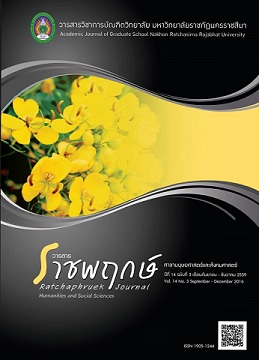การพัฒนารูปแบบการบริหารเชิงกลยุทธ์ที่ส่งผลต่อประสิทธิผลของโรงเรียนมัธยมศึกษาขนาดกลางในภาคตะวันออกเฉียงเหนือ
Main Article Content
Abstract
การวิจัยครั้งนี้มีความมุ่งหมายเพื่อ 1) พัฒนารูปแบบการบริหารเชิงกลยุทธ์ที่ส่งผลต่อประสิทธิผลของโรงเรียนมัธยมศึกษาขนาดกลางในภาคตะวันออกเฉียงเหนือ 2) ตรวจสอบความเหมาะสมของรูปแบบการบริหารเชิงกลยุทธ์ที่ส่งผลต่อประสิทธิผลของโรงเรียนมัธยมศึกษาขนาดกลางในภาคตะวันออกเฉียงเหนือ 3) พัฒนาคู่มือการใช้รูปแบบการบริหารเชิงกลยุทธ์ที่ส่งผลต่อประสิทธิผลของโรงเรียนมัธยมศึกษาขนาดกลางในภาคตะวันออกเฉียงเหนือ ใช้วิธีวิจัยแบบผสมทั้งเชิงคุณภาพและเชิงปริมาณ การวิจัยแบ่งออก เป็น 4 ระยะ คือ ระยะที่ 1 การสร้างรูปแบบ โดยการศึกษาเอกสารและงานวิจัยที่เกี่ยวข้อง การสัมภาษณ์ผู้ทรงคุณวุฒิ จำนวน 9 คน และการศึกษาพหุกรณีโรงเรียนต้นแบบ จำนวน 4 โรงเรียน ระยะที่ 2 การพัฒนารูปแบบการบริหารเชิงกลยุทธ์ที่ส่งผลต่อประสิทธิผลของโรงเรียนมัธยมศึกษาขนาดกลางในภาคตะวันออกเฉียงเหนือ โดยเทคนิคเดลฟายแบบปรับปรุง 3 รอบ ผู้เชี่ยวชาญ จำนวน 21 คน ระยะที่ 3 การตรวจสอบรูปแบบการบริหารเชิงกลยุทธ์ที่ส่งผลต่อประสิทธิผลของโรงเรียนมัธยมศึกษาขนาดกลางในภาคตะวันออกเฉียงเหนือ โดยการสอบถามผู้บริหารสถานศึกษา จำนวน 50 คน ครู จำนวน 400 คน และประธานกรรมการสถานศึกษาขั้นพื้นฐาน จำนวน 50 คน รวมทั้งสิ้น 500 คน ระยะที่ 4 การจัดทำและตรวจสอบคู่มือการใช้รูปแบบการบริหารเชิงกลยุทธ์ที่ส่งผลต่อประสิทธิผลของโรงเรียนมัธยมศึกษาขนาดกลางในภาคตะวันออกเฉียงเหนือ
ผลการวิจัยพบว่า
1. รูปแบบการบริหารเชิงกลยุทธ์ที่ส่งผลต่อประสิทธิผลของโรงเรียนมัธยมศึกษาขนาดกลางในภาคตะวันออกเฉียงเหนือ ประกอบด้วย 3 องค์ประกอบ ได้แก่ องค์ประกอบที่ 1 ปัจจัยที่เอื้อต่อการบริหารโรงเรียน มี 5 ด้าน ได้แก่ 1) ภาวะผู้นำของผู้บริหาร 2) การมีส่วนร่วมของผู้มีส่วนได้ส่วนเสีย 3) บรรยากาศขององค์กร 4) การพัฒนาบุคลากร และ 5) ทรัพยากรทางการบริหาร องค์ประกอบที่ 2 กระบวนการบริหารเชิงกลยุทธ์ มี 4 ขั้นตอน ได้แก่ 1) การวิเคราะห์สภาพแวดล้อม 2) การกำหนดกลยุทธ์ 3) การนำกลยุทธ์ไปปฏิบัติ และ 4) การประเมินกลยุทธ์ องค์ประกอบที่ 3 ประสิทธิผลของโรงเรียนมี 3 ด้าน ได้แก่ 1) ผลสำเร็จของการบริหาร 2) คุณภาพของผู้เรียน และ 3) ความพึงพอใจของผู้มีส่วนเกี่ยวข้อง
2. รูปแบบการบริหารเชิงกลยุทธ์ที่ส่งผลต่อประสิทธิผลของโรงเรียนมัธยมศึกษาขนาดกลางในภาคตะวันออกเฉียงเหนือ ที่พัฒนาขึ้นมีความสอดคล้องกับข้อมูลเชิงประจักษ์ โดยภาพรวมมีความเหมาะสม อยู่ในระดับมากที่สุด ( = 4.93, S.D.= 0.29) เมื่อพิจารณาเป็นรายองค์ประกอบมีความเหมาะสมอยู่ในระดับมากที่สุดทั้ง 3 องค์ประกอบหลัก เรียงลำดับ ค่าเฉลี่ยขององค์ประกอบหลักจากมากไปหาน้อยได้ดังนี้ ประสิทธิผลของโรงเรียน (
= 4.97, S.D. = 0.18) กระบวนการบริหารเชิงกลยุทธ์ (
= 4.95, S.D. = 0.22) และปัจจัยที่เอื้อต่อการบริหารโรงเรียน (
= 4.92, S.D. = 0.33) ตามลำดับ
3. คู่มือการใช้รูปแบบการบริหารเชิงกลยุทธ์ที่ส่งผลต่อประสิทธิผลของโรงเรียนมัธยมศึกษาขนาดกลาง สังกัดสำนักงานเขตพื้นที่การศึกษามัธยมศึกษาในภาคตะวันออกเฉียงเหนือ มีความเหมาะสมในการนำไปใช้ในการบริหารงานวิชาการ โดยมีเนื้อหาประกอบด้วย คำชี้แจง ความนำองค์ประกอบของรูปแบบการบริหารเชิงกลยุทธ์ที่ส่งผลต่อประสิทธิผลสำหรับโรงเรียนขนาดกลางในภาคตะวันออกเฉียงเหนือ และการดำเนินงานตามรูปแบบการบริหารเชิงกลยุทธ์ที่ส่งผลต่อประสิทธิผลของโรงเรียนมัธยมศึกษาขนาดกลางในภาคตะวันออกเฉียงเหนือ
A Development of Strategic Administration Model Affecting the Effectiveness of Middle-Sized School under the Office of Secondary Educational Service Area Office in the Northeast Thailand
The objectives of this study were to 1) study the development of strategic administration model affecting effectiveness middle-sized school under the office of Secondary Educational Service Area Office in the Northeast Region of Thailand, and 2) to check the model with empirical data and 3) to construct and create handbook of the model. Mixed methods research of qualitative and quantitative researches was employed in this study. It was conducted in 4 phases. The first phase was the model drafting conducted in 3 steps; step 1: studied documentation and research, step 2 : interviewed 9 experts, and step 3: multi-case studies of 4 best practice’s schools. The second phase was to run the model development by the implementation of modified Delphi technique for 3 times with 21 experts, and the third phase was the model examination by using a 5-level rating scale questionnaire with 500 stakeholders.
The study revealed the following results;
1. There were 3 components for strategic administration model affecting effectiveness of middle-sized school under the office of Secondary Educational Service Area Office in the Northeast Region of Thailand. First component was 5 issues of the school administration supporting factors, 1) school administrator leadership, 2) participation of stakeholders, 3) organizational climate, 4) human resource development, and 5) resource management. The second component was four steps of the strategic management process; 1) SWOT analysis 2) strategic planning 3) strategic practice and 4) strategic evaluation. The third component was three issues of the school effectiveness ; 1) successful management, 2) quality students and 3) satisfaction of stakeholder.
2. The developed strategic administration model effecting effectiveness Model was consistent with
empirical data. Overall was the most appropriate level ( = 4.86, S.D. = 0.39), when considering the elements was in most every component. By mean value, each component could be prioritized from highest to lowest as follows: the school effectiveness (
= 4.97, S.D. = 0.18) was at the highest level, the process of the strategic management (
= 4.95, S.D. = 0.22) was at the highest level, also the school administration supporting factors (
= 4.92, S.D. = 0.33) was at the highest level.
3. Manual model of the development of strategic administration model was suitable to use. The contents include explanation, introduction, component of the development of strategic administration model effecting the model’s effectiveness and the progress of the strategic administration model.


